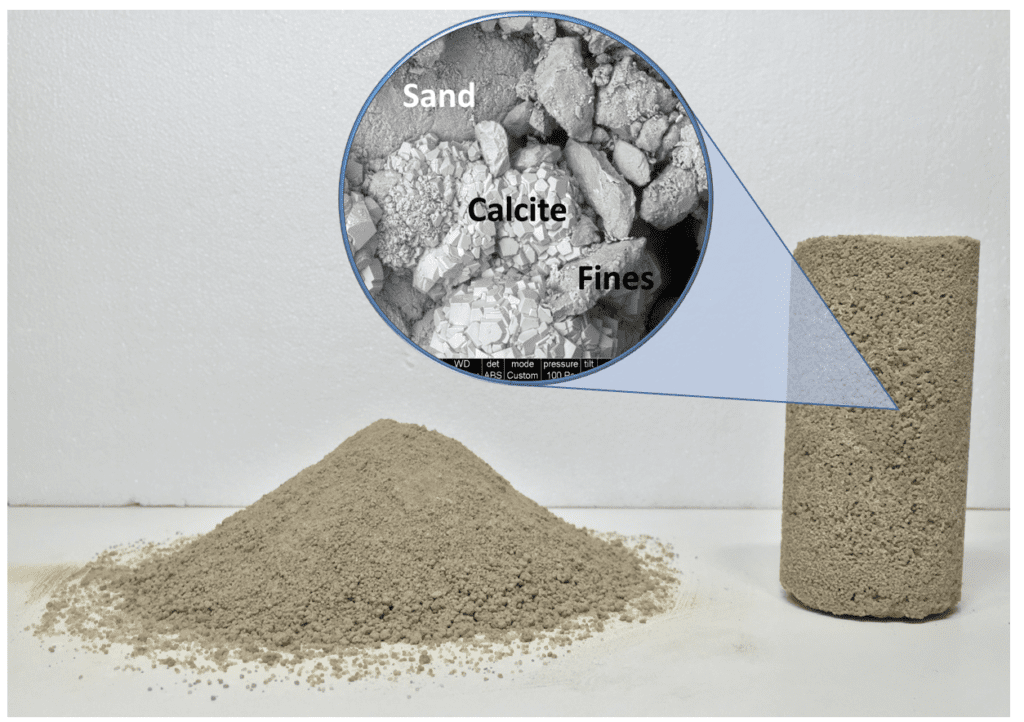A new study published in Canadian Geotechnical Journal suggests that an enzyme derived from bacteria could be used to enhance the stability of certain soils.
Bacteria are a key component of soil—there can be more than a billion bacterial cells in a single gram of earth. These microbes, along with the chemicals they produce, impact not only the soil’s fertility, but also its physical characteristics. One example is the natural process by which sand becomes sandstone.
“Sandstone is exactly what it sounds like: sand grains bonded together into a stone,” said James Alleman, a civil engineering professor at Iowa State University and the co-author on the paper. “Mother Nature uses a biological method to achieve this, but it takes tens of thousands of years. We do the same thing, but in a matter of days.”
Certain bacteria (as well as some plants) secrete an enzyme called urease that breaks down urea, a compound found in animal waste. They do this to extract nitrogen that they use to build their cells.
But this process also raises the pH of the soil, kicking off a cascade of other chemical reactions. One of them produces calcite, the same mineral found in seashells. Crystals of calcite act like cement, bonding together adjacent grains of sand.
The idea of adding urease-producing bacteria to the soil on purpose to manipulate its stability was proposed by Canadian researchers decades ago but has never been applied commercially.
In part, this is because it can be difficult for injected bacteria to permeate deeply into the soil. The void spaces between sand grains are usually filled with smaller particles such as silt or clay, and the bacteria are simply too big to fit through.
By contrast, the urease enzyme is orders of magnitude smaller than a bacterial cell. Previous researchers have reported some success using urease extracted from a plant known as jack bean to increase the stability of soils.
But growing plants is slow and costly compared with growing bacteria. In their lab, Alleman and his team have fermenters that can rapidly produce large number of urease-producing bacterial cells.
“In two days time, we can grow a vastly larger quantity of enzyme that you’d be able to grow in 150 days with jack bean,” he said.
The team added the enzyme to sample soils in the lab and tested its unconfined compressive strength, a measure of how much load it can carry before it breaks.
“After one day, if you press it with your finger, it basically collapses,” said Alleman. “But after two days, it’s noticeably different. By day three, it’s starting to feel like rock.” The tests showed comparable results to those done with urease extracted from jack bean but at a much lower theoretical cost.
Alleman cautions that more research will have to be done before commercial application can be considered, but he’s optimistic about the potential of the technology.
“Imagine you were a homeowner in San Francisco,” he said. “If you could drill some holes underneath the foundation, inject this stuff, and solidify the ground under your house, that would go a long way toward preventing damage in the face of an earthquake.”

Researchers from Iowa State University have used an enzyme extracted from bacteria to increase the stability of soil. (Image | Tung P. Hoang)
Read the full study: Sand and silty-sand soil stabilization using bacterial enzyme induced calcite precipitation (BEICP) in Canadian Geotechnical Journal.




